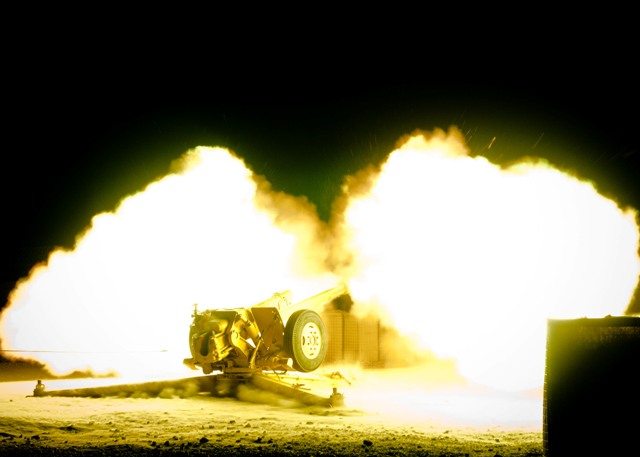Afghan National Army field artillery lit the night sky for the first time ever in eastern Paktika province last week, as a newly emplaced howitzer battery became tactically operational.
Part of the expanding arsenal of Afghan National Security Forces in eastern Afghanistan, this 122mm D30 battery based at Forward Operation Base Orgun-E fired a training illumination mission to mark their arrival on the front lines.
“We can do a lot with these guns,” said Afghan Army Capt. Daswood Shah, speaking of the capabilities this battery brings to Paktika. “We can support our patrols ourselves, we can support our checkpoints. This is an important capability.”
Shah is the commander and he swells with pride as he talks about the new battery he commands.
“I am proud to be an Afghan National Army commander,” said Shah. “My men and I are very proud to be able to support our infantry in combat.”
The pride Shah and his men feel is well deserved. Just one short year ago, none of them had ever worked with a howitzer, not even Shah, he said.
Training in Gardez for the last several months, the battery learned the fundamentals of field artillery employment and certified for tactical operations in late March, Shah said.
After certification, they began moving to their new home in eastern Paktika Province near the border of Pakistan as the next step toward full combat capability.
“This is the second step,” said U.S. Army Capt. Sean Grubofski, commander of Battery A, 1st Battalion, 77th Field Artillery Regiment, 172nd Infantry Brigade. “The first step was occupying a joint firing point here in Orgun-E and maintaining that firing point.”
Grubofski’s soldiers are serving as advisers for the fledgling Afghan battery, he said.
They train together daily, both on the guns and in their fire direction centers, which occupy adjacent sides of the same room.
“The next step is tactically employing fires as an enabler for maneuver operations,” said Grubofski.
The night illumination mission served as an important milestone for the Afghan gunners, said Grubofski.
“It’s a confidence builder, not only for the battery, but for the Kandak as well,” he said. “It displays both their accuracy and their high level of technical proficiency.”
The biggest hurdle left to overcome, the advisers agreed, is the speed at which the Afghan soldiers calculate the fire missions and deliver rounds on their targets. All of this will come as they gain more experience, Grubofski said.
Grubofski said that given the level of skill displayed by the Afghan battery, independent ANSF fire support could be a reality in the next nine months.
“Currently they are effective with advisers,” said Grubofski. “Over the next nine-month period they will become effective in a partnered capacity. The final step is unilateral operations.”
Shah said he sees his role, and the role of his battery, as an important step towards peace in Afghanistan.
“I will be the proudest when we are done with the war,” Shah said. “We have been fighting for three decades. My dream is the day we will no longer have to fight and can begin to rebuild our country.”










